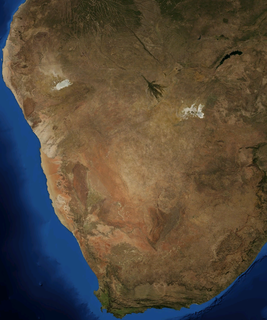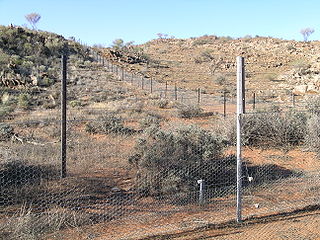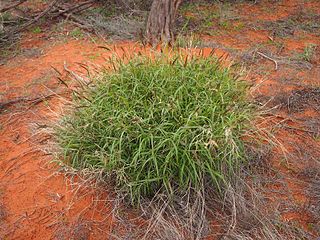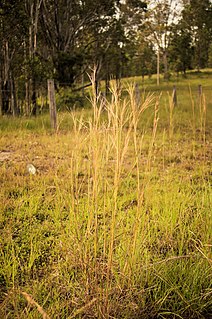
The Kalahari Desert is a large semi-arid sandy savannah in Southern Africa extending for 900,000 square kilometres (350,000 sq mi), covering much of Botswana, and parts of Namibia and South Africa.

Overgrazing occurs when plants are exposed to intensive grazing for extended periods of time, or without sufficient recovery periods. It can be caused by either livestock in poorly managed agricultural applications, game reserves, or nature reserves. It can also be caused by immobile, travel restricted populations of native or non-native wild animals. However, "overgrazing" is a controversial concept, based on equilibrium system theory. A strong indicator of overgrazing is where additional feed needs to be brought in from outside the farm, often to support livestock through the winter. Traditionally this feed was sourced on the farm, with fewer animals being kept and some fields being used for hay and silage production. Modern farm businesses often choose to keep more animals than their land can support alone; buying in external feed to offset this.

Millets are a group of highly variable small-seeded grasses, widely grown around the world as cereal crops or grains for fodder and human food.

Poaceae or Gramineae is a large and nearly ubiquitous family of monocotyledonous flowering plants known as grasses. It includes the cereal grasses, bamboos and the grasses of natural grassland and species cultivated in lawns and pasture. The latter are commonly referred to collectively as grass.

Grasslands are areas where the vegetation is dominated by grasses (Poaceae). However, sedge (Cyperaceae) and rush (Juncaceae) can also be found along with variable proportions of legumes, like clover, and other herbs. Grasslands occur naturally on all continents except Antarctica and are found in most ecoregions of the Earth. Furthermore, grasslands are one of the largest biomes on earth and dominate the landscape worldwide. They cover 31-43% of the earth's surface. There are different types of grasslands: natural grasslands, semi-natural grasslands, and agricultural grasslands.

Rangelands are grasslands, shrublands, woodlands, wetlands, and deserts that are grazed by domestic livestock or wild animals. Types of rangelands include tallgrass and shortgrass prairies, desert grasslands and shrublands, woodlands, savannas, chaparrals, steppes, and tundras. Rangelands do not include forests lacking grazable understory vegetation, barren desert, farmland, or land covered by solid rock, concrete and/or glaciers.

Páramo can refer to a variety of alpine tundra ecosystems. Some ecologists describe the páramo broadly as "all high, tropical, montane vegetation above the continuous timberline". A more narrow term classifies the páramo according to its regional placement in the northern Andes of South America and adjacent southern Central America. The páramo is the ecosystem of the regions above the continuous forest line, yet below the permanent snowline. It is a "Neotropical high mountain biome with a vegetation composed mainly of giant rosette plants, shrubs and grasses". According to scientists, páramos may be "evolutionary hot spots" and among the fastest evolving regions on Earth.

Cenchrus ciliaris is a species of grass native to most of Africa, southern Asia, southern Iran, and the extreme south of Europe (Sicily). Other names by which this grass is known include dhaman grass, anjan grass, koluk katai and buffelgrass.

The tropical grass species Pennisetum clandestinum is known by several common names, most often kikuyu grass, as it is native to the highland regions of East Africa that is home to the Kikuyu people. Because of its rapid growth and aggressive nature, it is categorised as a noxious weed in some regions. However, it is also a popular garden lawn species in Australia, New Zealand, South Africa and the southern region of California in the United States, as it is inexpensive and moderate drought-tolerant. In addition, it is useful as pasture for livestock grazing and serves as a food source for many avian species, including the long-tailed widowbird. The flowering culms are very short and "hidden" amongst the leaves, giving this species its specific epithet (clandestinum).

Andropogon virginicus is a species of grass known by several common names, including broomsedge bluestem, yellowsedge bluestem and whiskey grass. It is native to the southeastern United States and as far north as the Great Lakes. It is known as an introduced species in California and Hawaii, where it is weedy.

Nardus is a genus of plants belonging to the grass family, containing the single species Nardus stricta, known as matgrass. It is placed in its own tribe Nardeae within the subfamily Pooideae. The name derives from ancient Greek nardos (νάρδος) from the earlier Akkadian lardu. It is not to be confused with spikenard, Nardostachys jatamansi.

Renosterveld is a term used for one of the major plant communities and vegetation types of the Cape Floristic Region which is located in southwestern and southeastern South Africa, in southernmost Africa. It is an ecoregion of the Mediterranean forests, woodlands, and scrub biome.

Sartidia is a genus of Southern African and Madagascan plants in the grass family. It was split from Aristida in 1963 by South African botanist Bernard de Winter and contains six known species, of which Sartidia perrieri is considered extinct. Their natural habitats are warm, semi-arid savanna and dry forest at altitudes of 800–2,000 m (2,600–6,600 ft) where rainfall ranges from 250 to 1,500 mm per year. They are perennial grasses with inflorescence in a panicle.

Stipagrostis is a genus of African, Asian, and Russian plants in the grass family.

Hyparrhenia filipendula is a species of perennial bunchgrass commonly known as Tambookie grass, fine thatching grass, and fine hood grass. It grows to a height of 1 to 1.5 metres.

Pennisetum pedicellatum, known simply as desho or as desho grass, is an indigenous grass of Ethiopia of the monocot angiosperm plant family Poaceae. It is also known as annual kyasuwa grass in Nigeria, bare in Mauritania, and deenanath grass in India. It grows in its native geographic location, naturally spreading across the escarpment of the Ethiopian highlands. Widely available in this location, it is ideal for livestock feed and can be sustainably cultivated on small plots of land. Thus desho is becoming increasingly utilized, along with various soil and water conservation techniques, as a local method of improving grazing land management and combating a growing productivity problem of the local region.
Eragrostis truncata is a grass native to Namibia, Botswana, and South Africa. Found most abundantly in the Nama Karoo, the plant is registered under the SANBI Red List as "safe" (LC).

Stipagrostis namaquensis is a species of grass native to South Africa and Namibia, especially in the Nama Karoo. It is listed as "safe" (LC) on the SANBI Red List.

Grazing is a method of feeding in which a herbivore feeds on low-growing plants such as grasses or other multicellular organisms, such as algae. Many species of animals can be said to be grazers, from large animals such as hippopotamuses to small aquatic snails. Grazing behaviour is a type of feeding strategy within the ecology of a species. Specific grazing strategies include graminivory ; coprophagy ; pseudoruminant ; and grazing on plants other than grass, such as on marine algae.
Stipagrostis hirtigluma is a dense, perennial tufted grass. It occurs in bushveld, karoo and desert regions. It grows in dry, warm parts, in stony or sandy places and on rocky outcrops.


















